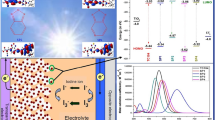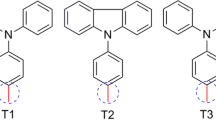Abstract
In this paper, we performed theoretical studies on the twelve D-A-π-A type organic dyes (G-1 ~ G-3, M-1 ~ M-3, J-1 ~ J-3, and S-1 ~ S-3) with 9-phenylcarbazole as the electron donor in anticipation of the application of these dyes in dye-sensitized solar cells (DSSCs). DFT and TD-DFT methods are applied to investigate in detail the molecular geometries, frontier molecular orbitals (FMOs), absorption spectra, charge density difference (CDD), and transition density matrix (TDM) of several dyes. The results show that the M-series (M-1 ~ M-3) dyes have the largest dihedral angles between the electron donor and the auxiliary acceptor and also has the largest energy gaps in HOMO–LUMO orbitals, which greatly reduces the charge transfer efficiency. Finally, the UV–Vis absorption spectra inferred that the anchoring groups modified with o-nitrobenzoic acid (G-3, M-3, J-3, S-3) can red-shift the absorption peaks of the dyes, which results in higher light-harvesting efficiency and improves the power conversion efficiency of DSSCs. Overall, all of these dyes contribute to the improvement of photovoltaic power conversion efficiency and have potential for application in DSSCs devices.








Similar content being viewed by others
Data Availability
No datasets were generated or analysed during the current study.
References
Hassan AU, Sumrra SH, Mustafa G, Noreen S, Ali A, Sara S et al (2023) Enhancing NLO performance by utilizing tyrian purple dye as donor moiety in organic DSSCs with end capped acceptors: a theoretical study. J Mol Graph Model 124:108538
Kumar V, Chetti P (2023) The impact of aromatic π-spacers and internal acceptors in triphenylamine dyes for DSSCs: a DFT approach. J Mol Graph Model 123:108512
Wang S, Yu Z, Li L, Qiao J, Gao L (2024) Theoretical analysis on D-π-A dye molecules with different acceptors and terminal branches for highly efficient dye-sensitized solar cells. J Mol Graph Model 127:108677
Iftikhar R, Irshad R, Zahid WA, Akram W, Shehzad RA, Abdelmohsen SAM et al (2023) Designing of fluorine-substituted benzodithiophene-based small molecules with efficient photovoltaic parameters. J Mol Graph Model 125:108588
Ma Y, Wang K, Zhang H, Liu H, Tian Y, Wang Y, Zhong C (2023) Sensitizers of metal complexes with sulfur coordination achieving a power conversion efficiency of 12.89%. Acs Appl Mater Interfaces 15(29):35251–35260
Zhang D, Stojanovic M, Ren Y, Cao Y, Eickemeyer FT, Socie E, Vlachopoulos N, Moser J-E, Zakeeruddin SM, Hagfeldt A, Gratzel M (2021) A molecular photosensitizer achieves a Voc of 1.24V enabling highly efficient and stable dye-sensitized solar cells with copper(II/I)-based electrolyte. Nat Commun 12(1):1777
Cui Y, Yao H, Zhang J, Zhang T, Wang Y, Hong L, Xian K, Xu B, Zhang S, Peng J, Wei Z, Gao F, Hou J (2019) Over 16% efficiency organic photovoltaic cells enabled by a chlorinated acceptor with increased open-circuit voltages. Nat Commun 10:2515
Zhao C, Zhang Z, Ran X, Zhang T, Yu X, Jin L (2024) Screening novel candidates of ZL003-based organic dyes for dye-sensitized solar cells by modifying auxiliary electron acceptors: A theoretical study. Spectrochim Acta Part A-Mol Biomol Spectrosc 310:123880
Hosseinnezhad M, Gharanjig K, Moradian S (2020) New D-A–π–A organic photo-sensitizer with thioindoxyl group for efficient dye-sensitized solar cells. Chem Pap 74:1487–1494
Wang T, Hao X, Han L, Li Y, Ye Q, Cui Y (2021) D-A-π-A carbazole dyes bearing fluorenone acceptor for dye sensitized solar cells. J Mol Struct 1226:129367
Cui L, Zhou J, Zhang Y, Meng X, Wang H, Liu B (2023) Molecular engineering of auxiliary acceptor for the development of efficient organic D-A-π-A sensitizers. Dyes Pigm 216:111322
Wang Y, Yan Y, Liu D, Wang Y, Wang G, Yu X (2018) Ultrafast dynamics of a triphenylamine-based tri-branched derivative with potential application as two-photon polymerization initiator. Appl Phys A-Mater Sci Process 124:539
Wang Y, Jiang Y, Liu D, Wang Y, Wang G, Hua J (2017) Ultrafast relaxation processes of multi-branched compounds based on 1,3,5-triazine: an investigation of the causes of a high fluorescence quantum yield after modification with perfluoroalkyl chains. J Lumin 190:89–93
Wang Y, Jiang Y, Liu D, Wang Y, Wang G, Hua J (2018) Ultrafast responses of two V-shaped compounds with a reverse conjugated structural configuration: an investigation of the reason for the enhanced two-photon absorption cross-section. Appl Phys B-Lasers Opt 124:98
Meng X, Hong L, Jiang Y, Liu D, Hua J, Wang Y (2023) Thiophene-modified donor-z-acceptor compound with an enhanced two-photon absorption response: an ultrafast dynamics study. J Lumin 263:119994
Liu W, Wang Y, Sun J, Liu D, Wang G, Fang Q (2020) Optical limiting property and ultrafast pump-probe study of two X-shaped oligomers with anthracene unit as a core. Optik 206:164330
Ammasi A, Munusamy AP, Shkir M (2022) Computational investigations on acceptor substituent influence of metal-free efficient chromophores for optoelectronic properties. J Mol Model 28:349
Fitri A, Benjelloun AT, Benzakour M, McHarfi M, Hamidi M, Bouachrine M (2014) Theoretical design of thiazolothiazole-based organic dyes with different electron donors for dye-sensitized solar cells. Spectrochim Acta Part A Mol Biomol Spectrosc 132:232–238
Fadili D, Fahim ZME, Alioui A, Bouzzine SM, Hamidi M (2024) Enhancing optoelectronic properties of phosphonic acid based dyes via donor unit variation: a DFT/TD-DFT investigation. Mater Today Commun 38:108126
Goerigk L, Grimme S (2011) A thorough benchmark of density functional methods for general main group thermochemistry, kinetics, and noncovalent interactions. Phys Chem Chem Phys 13:6670–6688
Schaefer H, Ahlrichs Horn R (1992) Fully optimized contracted Gaussian basis sets for atoms li to Kr. J Chem Phys 97:2571–2577
Schaefer C, Ahlrichs Horn R (1994) Fully optimized contracted Gaussian basis sets of triple zeta valence quality for atoms li to Kr. J Chem Phys 100:5829–5835
Perdew JP, Burke K, Ernzerhof M (1996) Generalized gradient approximation made simple. Phys Rev Lett 77:3865–3868
Perdew JP, Burke K, Ernzerhof M (1997) Generalized Gradient Approximation Made Simple [Phys. Re. Lett. 77, 3865 (1996)]. Phys Rev Lett 78:1396-
Adamo C, Barone V (1999) Toward reliable density functional methods without adjustable parameters: The PBE0 model. J Chem Phys 110:6158–6170
Neese F (2022) Software update: the ORCA program system-Version 5.0. Wiley Interdiscip Rev-Comput Mol Sci 12:e1606
Lu T, Chen F (2012) Multiwfn: a multifunctional wavefunction analyzer. J Comput Chem 33:580–592
Humphrey W, Dalke A, Schulten K (1996) VMD: Visual molecular dynamics. J Mol Graph Model 14:33–38
Mao J, Zhang X, Liu S-H, Shen Z, Li X, Wu W, Chou P-T, Hua J (2015) Molecular engineering of D-A-π-A dyes with 2-(1,1-dicyanomethylene)rhodanine as an electron-accepting and anchoring group for dye-sensitized solar cells. Electrochim Acta 179:179–186
Choi IT, You BS, Eom YK, Ju MJ, Choi WS, Kang SH, Kang MS, Seo KD, Hong JY, Song SH, Yang J-W, Kim HK (2014) Triarylamine-based dual-function coadsorbents with extended π-conjugation aryl linkers for organic dye-sensitized solar cells. Org Electron 15(11):3316–3326
Nishiwaki N (2020) A walk through recent nitro chemistry advances. Molecules 25(16):3680
Zhang T (2021) Lu, Efficient evaluation of electrostatic potential with computerized optimized code. Phys Chem Chem Phys 36:20323–20328
Sakr MAS, Sherbiny FF, El-Etrawy A-AS (2022) Hydrazone-based materials; DFT, TD-DFT, NBO analysis, fukui function, MESP analysis, and solar cell applications. J Fluoresc 32:1857–1871
Makarova MV, Akkuratov AV, Sideltsev ME, Stevenson KJ, Romadina EI (2022) Novel ethylene glycol substituted benzoxadiazole and benzothiadiazole as anolytes for nonaqueous organic redox flow batteries. Chem Electro Chem 9:e202200483
Wang P, Zhang S (2023) Synthesis of oxindoles via SmI2 -promoted reduction of 2-nitrophenylacetic acids. Synthesis-Stuttgart 56(01):171–178
Abaid Samawi K, Abd-Alkuder Salman E, Abd-Alsatar Alshekhly B, Fawzi Nassar M, Yousefzadeh Borzehandani M, Abdulkareem-Alsultan G et al (2022) Rational design of different π-bridges and their theoretical impact on indolo[3,2,1-jk]carbazole based dye-sensitized solar cells. Comput Theor Chem 1212:113725
Saha A, Ganguly B (2022) DFT exploration to tune the silyl group as anchoring unit on the performance of dye-sensitized solar cells: an approach to suppress dye leaching from semiconductor surface. J Mol Model 28:131
Kerraj S, Salah M, Chtita S, El Idrissi M, Belaaouad S, Mohammed M et al (2022) Theoretical study of photovoltaic performances of Ru, Rh and Ir half sandwich complexes containing N, N chelating ligands in Dye-Sensitized Solar Cells (DSSCs). DFT and TD-DFT investigation. Comput Theor Chem 1209:113630
Goode-Romero G, Winnberg U, Domínguez L, Ibarra IA, Vargas R, Winnberg E et al (2020) New information of dopaminergic agents based on quantum chemistry calculations. Sci Rep 10:21581
Zhang D, Liu W, Yin S, Wang G, Liu D, Fang Q et al (2023) Photophysical properties of several multi-branched oligomers: an ultrafast excited state dynamics and quantum chemical calculation study. J Nonlinear Opt Phys Mater 2350079
Hashmat U, Rasool N, Kausar S, Altaf AA (2023) Azo-guanidine-based novel molecules for dye-sensitized solar cell applications: a density functional theory study. Chem Pap 77:2031–2038
Funding
Not applicable.
Author information
Authors and Affiliations
Contributions
G.M.J.S. and Z.L.P. are responsible for manuscript writing. W.W.B. and Y.Z.S. are responsible for data processing. D.X.C. and Y.Y. are responsible for article proofreading. W.S.H. is responsible for graphic beautification.
Corresponding authors
Ethics declarations
Ethical Approval
Not applicable.
Competing Interests
The authors declare no competing interests.
Additional information
Publisher's Note
Springer Nature remains neutral with regard to jurisdictional claims in published maps and institutional affiliations.
Supplementary Information
Below is the link to the electronic supplementary material.
Rights and permissions
Springer Nature or its licensor (e.g. a society or other partner) holds exclusive rights to this article under a publishing agreement with the author(s) or other rightsholder(s); author self-archiving of the accepted manuscript version of this article is solely governed by the terms of such publishing agreement and applicable law.
About this article
Cite this article
Gong, M., Zeng, L., Wang, W. et al. Effects of Several Auxiliary Acceptors and Anchoring Groups on Charge Transfer and Photophysical Properties of D-A-π-A Type DSSCs: A DFT Study. J Fluoresc (2024). https://doi.org/10.1007/s10895-024-03685-x
Received:
Accepted:
Published:
DOI: https://doi.org/10.1007/s10895-024-03685-x




